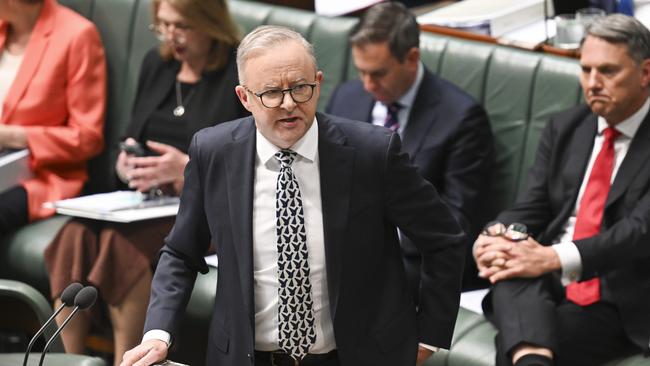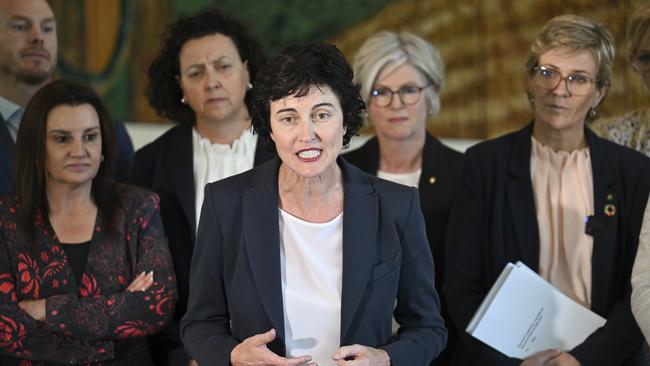
Australians will trudge to the polling booths in 2025 with a federal election likely in April or May. The last time a one-term incumbent was hurled from power in Australia was the Scullin Labor government, which suffered the particular misfortune of terrible timing. After a landslide win in the October 1929 election, James Scullin’s cabinet was sworn in two days before Black Thursday, the day Wall Street went into meltdown, ushering in the Depression.
Anthony Albanese’s Labor government will go to the people in a global environment where inflation or cost-of-living pressures are said to have overwhelmed the benefits of incumbency.
Among OECD nations, incumbents were shown the door in headline elections in the US and Britain. In Britain, Labour won a thumping majority in the House of Commons but Conservative party (23.7 per cent) and Reform UK votes (14.3 per cent) combined exceeded Labour’s vote (33.7 per cent) nationally in the first-past-the-post system.
In the US there was only Donald Trump, chauffeur-driven to the White House by the Democrats who thrust him back into the spotlight with a series of ill-fated indictments, then ignored their own diminishing working-class base and got the belting they deserved.
In Mexico, left-wing populist Claudia Sheinbaum was elected President and the party she represents in coalition with Mexico’s labour and green parties now holds a supermajority in the lower house Chamber of Deputies.
Incumbents were returned to power in Ireland and Iceland, and in France a loose collection of leftist parties now holds sway in the French National Assembly. With a few minor exceptions, overall the progressive/green vote went into sharp decline through Europe. In the EU election the Greens/EFA lost 18 of their 71 seats, and in Austria greens representation in the country’s National Council was cut by almost half.
In Australia, Labor lost power in Queensland, ending the party’s dominance where it had been in government for 29 of the past 35 years. In the Northern Territory, Labor sought to win a third consecutive term in government but was abandoned by voters while incumbent governments in Tasmania and the ACT were returned to power.
Incumbency is not quite the dead albatross necklace it would appear.

I saw Peter Dutton in Canberra three weeks ago and he is, to use a Keatingism, “stripped down and ready to go”. He looks fit for the rigours of a long campaign. It is his one shot in the locker and he looks like a man who will leave no stone unturned in his tilt at the Lodge.
Returning to government from where the Coalition stood after the 2022 election will not be easy.
Still, Dutton’s effectiveness as Opposition Leader can already be measured by the fact less than a year ago the Coalition was given zero chance of sitting on the Treasury benches in the 48th parliament and having some, albeit slight, chance now.
Early in 2024, the prevailing wisdom of polling and market research companies divined just two possibilities at the next election, a Labor majority government or a Labor minority government.
Labor’s primary vote has continued to fall and on the numbers as they stand the Coalition could win as many as nine seats from Labor, which would give it 67 seats and Labor 68.
The Coalition holds seven seats by a margin of less than 2 per cent and a further 11 by less than 4 per cent. Realistically, Labor would give itself a chance in perhaps two or three of these seats. On the other side of the ledger, Labor holds four seats by less than 1 per cent and a further six by less than 4 per cent, and I’d suggest they are all up for grabs.
The Liberal Party will need to regain most if not all of the seats it lost to the teals in 2022 to form majority government. Kate Chaney will have difficulty retaining Curtin in Perth’s northern beaches. Meanwhile, in Bradfield in Sydney’s upper north shore, the sitting Liberal MP Paul Fletcher is retiring and the seat is definitely in play. How will the Coalition’s nuclear policy play in Melbourne and Sydney’s leafy suburbs represented by teal independents?

In any event, the emerging punditry ignores our constitutional conventions. Where no party wins a majority, it is incumbent on the governor-general to ask the sitting prime minister if he is able to form government. Given that the crossbench will be of a similar size to what it is currently, with representation running the ideological gamut between the Greens and Katter’s Australia Party, Albanese is likely to respond in the affirmative and try his luck on the floor of the House of Representatives.
I will make one fairly uncontroversial prediction for the 2025 federal election: Labor will face big swings in many of its safe seats and perhaps lose a few it considered unlosable. Labor still may squeak through to form the next government but in the longer term it faces an existential crisis based on who it sees as its constituency.
It is a crisis the party has failed to address since the end of the Hawke-Keating era. If Labor is unable to arrest the decline, the party could face a veritable eternity in opposition, if not political oblivion.
Under Albanese’s faltering, directionless leadership, with Labor’s primary vote in the low 30 doldrums, almost anything is possible.
Albanese’s poor performance reveals a struggle between becoming Prime Minister and being Prime Minister. One story, possibly apocryphal, has Albanese meeting an old friend on the night of his electoral triumph in May 2022. “Can you believe it?” Albanese said to his childhood mate. “I’m Prime Minister.” Getting there is more important than staying there, apparently. Once there, it isn’t incumbency that’s a handicap. Poor performance is.







Welcome to 2025. It’s going to be a big one. It was said that 2024 was the year of elections around the world. While Australians watched the chaos unfold from afar, the new year offers our own dabble in democracy.